| |||||||
 |
| Search this Thread |  1,191,891 views |
| | #1 |
| Team-BHP Support  Join Date: Feb 2004 Location: Bombay
Posts: 24,037
Thanked: 34,067 Times
| Ford Fiesta : Test Drive & Review The Ford Fiesta has been launched in India at a price of Rs. 8.24 - 10.42 Lakhs (ex-Delhi). What you'll like about the Fiesta: • Futuristic front-end & stylish dashboard design • Great feature set including voice activation, auto-fold mirrors, cruise control, and more • ABS and Dual-airbags are standard across the range, including the entry variants • Ford’s torquey, fuel-efficient diesel engine • Excellent driving dynamics and impressive steering feel for an EPS What you won't: • Priced significantly higher than its competitors • Disproportionate rear end due to excessive bulk behind the rear wheel arches • Interiors at the rear look and feel like they are from a segment lower • Lackluster petrol engine, a disappointment for enthusiasts when compared to the old 1.6 • At low speeds, the suspension firmness accentuates the imperfections of the road The 2014 Facelift: • Link to Report 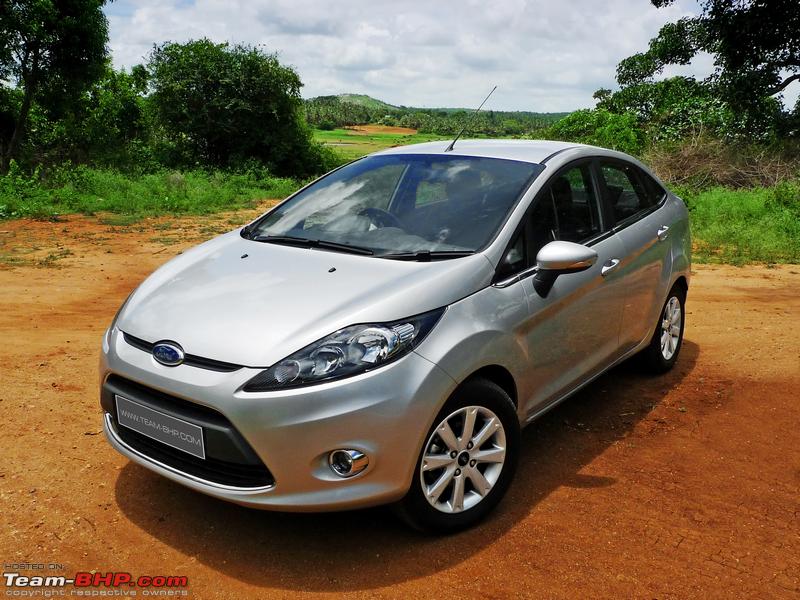 Last edited by GTO : 21st June 2014 at 15:42. Reason: Adding link to 2014 Facelift Report |
| |  (32)
Thanks (32)
Thanks
 |
| The following 32 BHPians Thank Rehaan for this useful post: | A M, architect, aryasanyal, azeemhafiz, basilmabraham, deetjohn, dhanushs, dot, echo77, Fordmanchau, frankmehta, GTO, Khandelwal, lijodavis, manishk83, nairrk, niravdd, pankaj_sachdeva, pjbiju, Poitive, SankalpDesai, speed kills, SunilM, Surprise, swiftnfurious, Technocrat, TheBeastFieast, Twiny, uday.ere, Urban_Nomad, vb-saan, xPK |
| |
| | #2 |
| Team-BHP Support  Join Date: Feb 2004 Location: Bombay
Posts: 24,037
Thanked: 34,067 Times
| Exterior This 6th generation Fiesta was launched in Europe in 2008, and then in North America and parts of Asia two years later. From the time of his arrival in 2006, Ford’s clinically efficient CEO Alan Mulally has led the blue oval to a successful turnaround, and taken the company from strength to strength. Indeed, Ford is the only American car manufacturer which has remained independent, and emerged profitable, after the great American depression that started in 2008 (GM & Chrysler, both, required a bailout from Washington). Key to Alan Mulally’s turnaround plan was the “One Ford” strategy, which means selling the same model across several global markets, with very minor changes from country to country. The new Fiesta is Ford’s first “One Ford” global car. Ford is currently on a roll, with the Figo single-handedly giving the American company previously unseen volumes in the Indian market. In only 1.5 years, the Figo has tripled Ford India’s monthly sales. Seeing what the Figo’s VFM pricing did to the car’s successful innings, the Fiesta needs to be well-priced from the get-go. The recent launch of the new Verna with its wide range of drive-trains and variants (link), the VW Vento’s sales figures dethroning the long-time segment leader, the City, in March (link), and Honda’s recent announcement of a chunky price-cut on the City (link) all greatly reduce the margin for error on the Fiesta’s pricing. It needs to be priced right from Day 1; there’s no scope for price-cuts, discounts and special editions as was the case with the Escort, Ikon and earlier Fiesta. The reason Ford hasn’t introduced the new Fiesta in an absolute basic variant is because it would overlap with the old Fiesta which is being sold side-by-side as the “Fiesta Classic” (at Rs. 5.49 – 8.52 lakhs ex-Delhi). Retaining the old Fiesta expands Fords offerings through the span of the C-segment, and helps take the fight to the Vento and Verna (especially) that have a wide variant range starting off at cheap, and topping out at expensive. EDIT: Pricing was announced on 14th July 2011. Refer to the price comparison below and it will be fairly evident that Ford has not been able to deliver the same kind of "value pricing" on the Fiesta like it had done with the Figo. Pricing comparo  Specs comparo  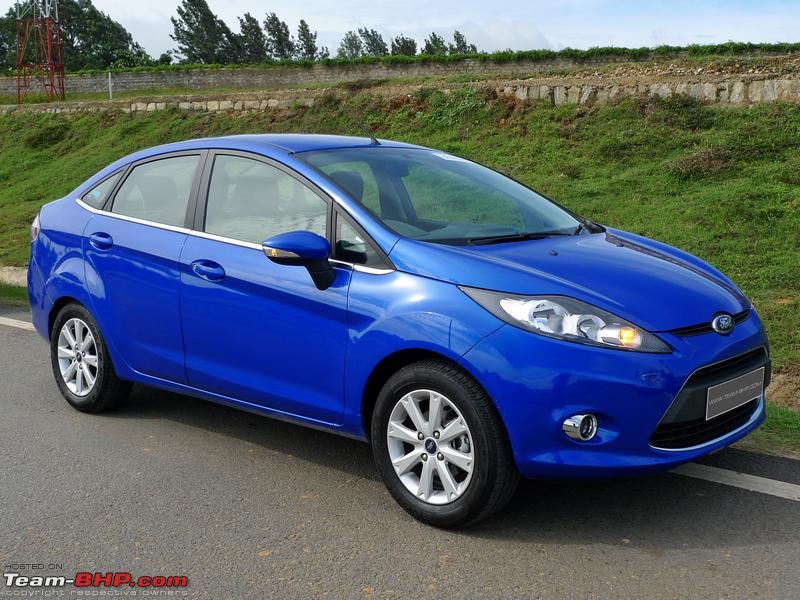 At the front, the chrome-lipped trapezoid grille and the multi-element headlamps work really well together to give it an aggressive head-on view. If you get a fleeting glance of a “Kinetic Blue” Fiesta in your rear view mirror, you can’t help but think you’re being chased by a close relative of the Focus RS. The side view shows the roofline starting way forward, from over the front wheel and swooping across as one long arc. The windshield has a shallow rake, making the front glass so tall that the wipers can only reach till 5-inches away from the top (Note: this doesn’t affect visibility at all). The window sill line is particularly low too, while blackened side pillars add to the effect of the long stretch of glass on the sides. Prominent wheel-arches carry through Ford’s existing design language. The Fiesta’s styling roots can be traced back to the Ford Verve concept car from the 2007 Frankfurt Motor show. The concept translated beautifully into the Fiesta hatchback sold abroad, though not quite as nicely into the sedan version we have here. By the time the ridges, lines and curves of the “kinetic design styling” reach the rear - they've angled up so high that there’s a lot of dead space left below them. This makes the rear look awkward, especially at the region behind the rear wheel-arch, resulting in an ungainly rear 3/4ths view. Not everyone can pull it off as well as J-Lo. This is no doubt the biggest visual turn-off with the Fiesta. For some, it might even be a deal breaker, whereas others might get used to it over time. The direct rear view is nowhere near as stylish or aggressive as the front. It looks heavy, and the high-perched tail-lamps only add to that feeling of hanging rear mass. The reflectors at the bottom of the bumper, and the visible parking sensors help break this up a little, but overall it’s still got that weighty rear end look. The doors have a solid feel to them. I’m not a big fan of using onomatopoeia to describe door-close quality, but yes, there is a definite thud there. The great part is that if you move the door to 8 inches or less from the closing position, the spring action will pull them shut perfectly. This will save you the trouble of the irritating re-open and re-slam-shut procedure that Murphy’s Law seems to only make happen when you’ve got your hands full. Boron steel has been brought up in a few Team-BHP discussions on the Fiesta. In short, it is a stronger/lighter and more expensive steel. Therefore, this ultra-high strength material has been used selectively in specific areas; namely around the A and B pillars and the lower rails. Despite this, the Fiesta weighs in at a significant 1217 Kgs (semi-official figure). I’ll let the pictures do the rest of the talking:  Futuristic front-end styling  The large swooping arc of the roof line. Coefficient of drag is 0.33 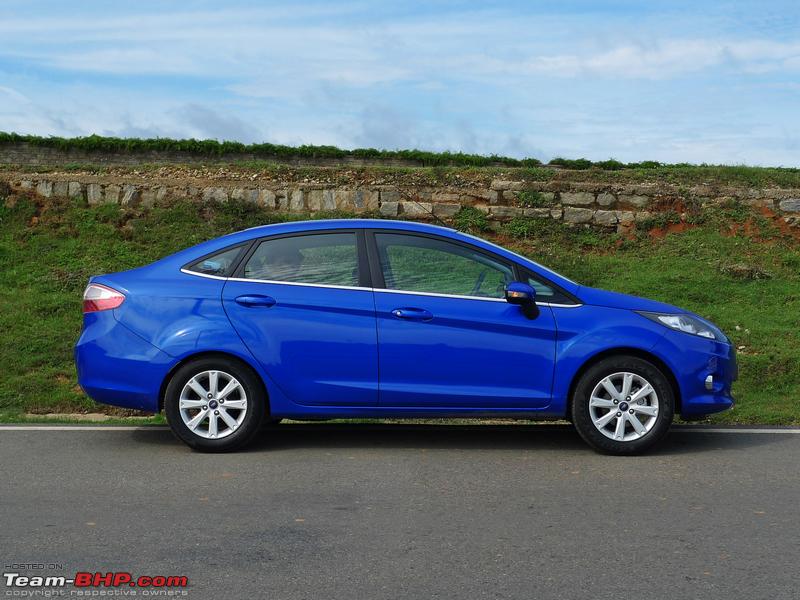 The least flattering angle by far. High tail-lamps leave a lot of dead space below 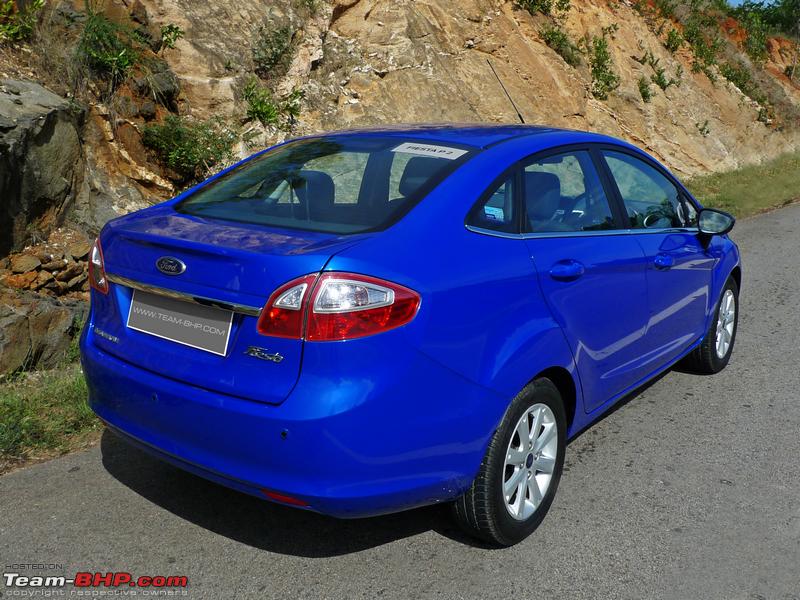 Tail lamps are placed very high, single reverse lamp and single fog light  195/60R15 tyres on 8-spoke alloy wheels. Drum brakes at the rear  Inverted trapezoid grill = a key element of Ford's new design language. Expect to see a lot more of this  Chromed window-line (notice how long it stretches for) further emphasized by the blacked out pillars  Multi-element headlamps + chrome capped fog lights  Aggressive front end with the evil stare of the headlamps  Auto-folding side mirrors are a huge plus for our Indian parking conditions 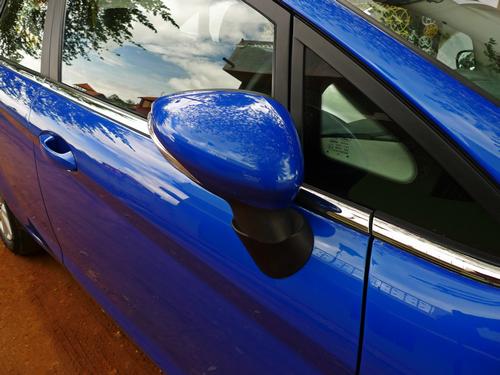 The sill-line angles upwards sharply once its past the rear passengers’ shoulders  The signature Fiesta badging. Tastefully applied chrome bits all around the exterior  Note the subtle spoiler lip, the raised shoulders, and the honeycomb detailing in the tail lamps  The exhaust pipe is tucked away behind the visually heavy rear bumper 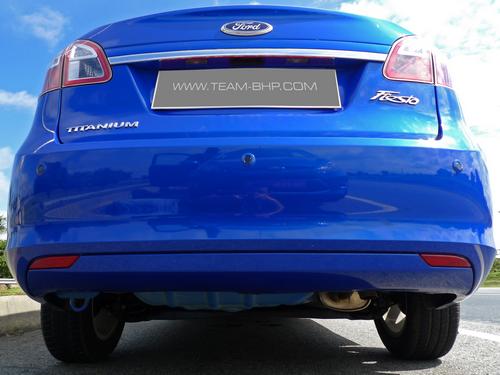 Twist-beam rear suspension at the rear, MacPhersons up front.  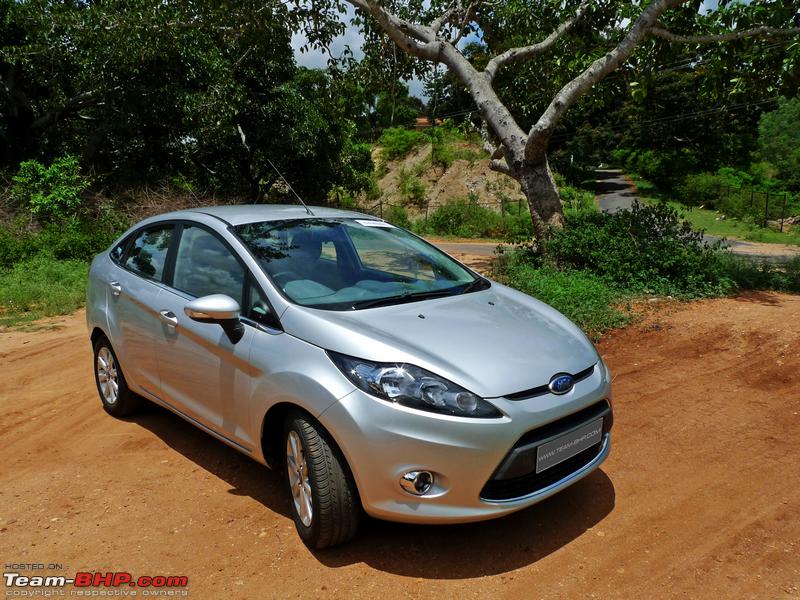 Folds and cuts of the kinetic styling are clearly visible in the top-down afternoon sun. A bit “fluidic” no? 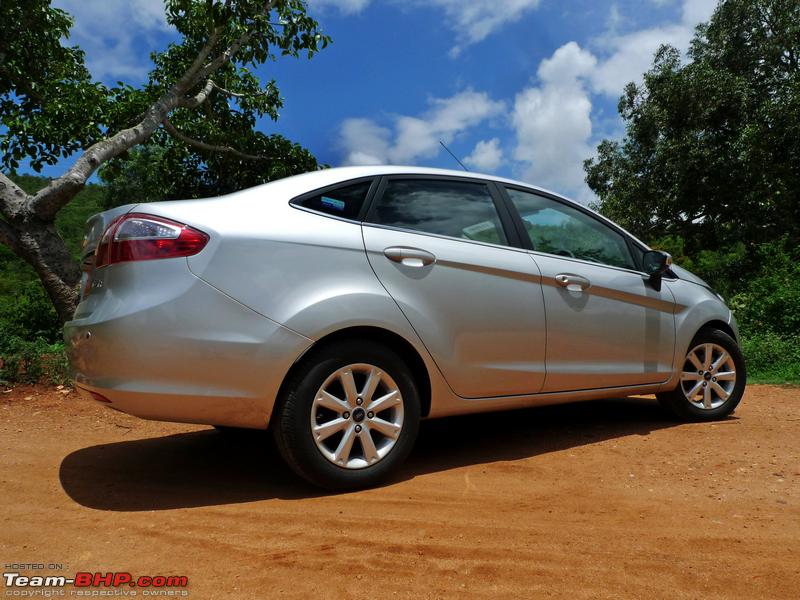 Chiseled cheekbones 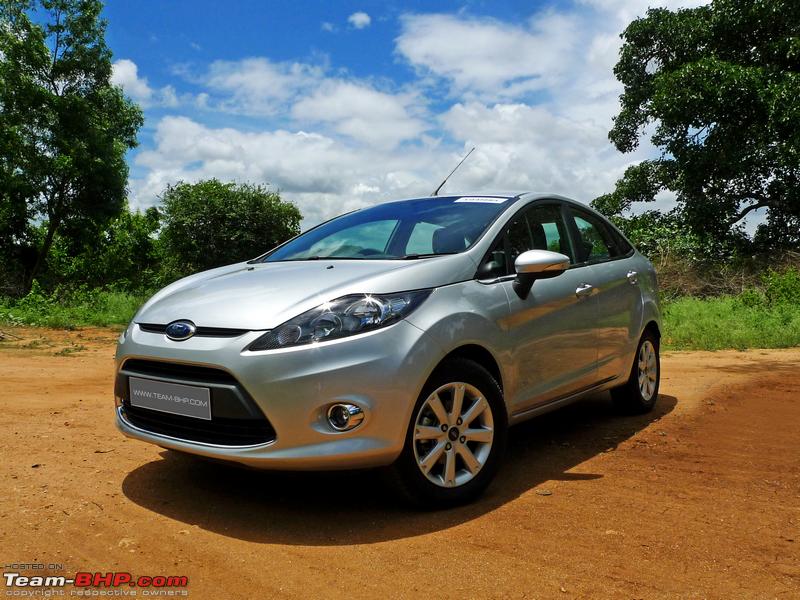 This should clear all your doubts about how big the new Fiesta is  Notice the difference in heights of the bottom of the window sills 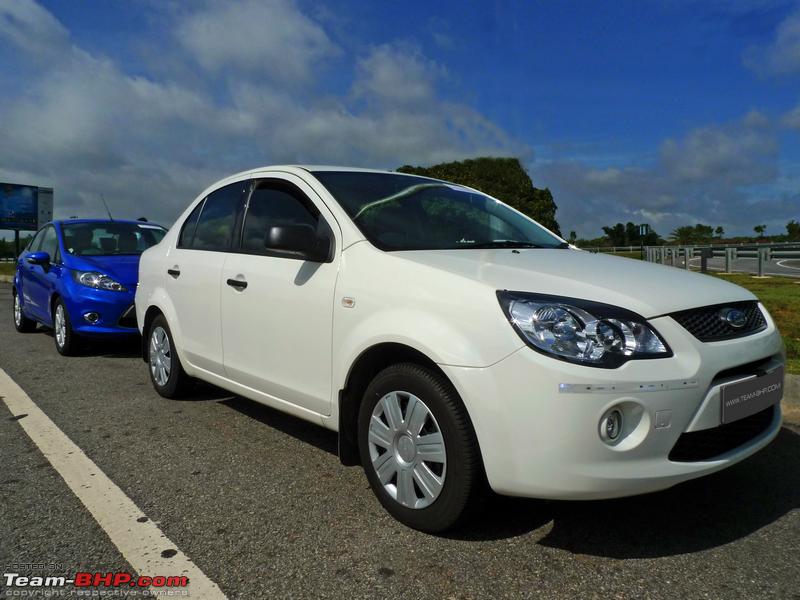 Last edited by Rehaan : 19th July 2011 at 16:51. Reason: Adding T-jet prices to comparo |
| |  (24)
Thanks (24)
Thanks
 |
| The following 24 BHPians Thank Rehaan for this useful post: | amitkb, architect, azeemhafiz, basilmabraham, dhanushs, echo77, FueledbyFury, jkumar007, Klub Class, kunalsb, lijodavis, manishk83, niravdd, optimist, petrolhead_neel, ramharis, SmartCat, Surprise, swiftnfurious, Technocrat, TheBeastFieast, vhharan1, Xehaust, xPK |
| | #3 |
| Team-BHP Support  Join Date: Feb 2004 Location: Bombay
Posts: 24,037
Thanked: 34,067 Times
| Interiors  At the Front Slip in to the front seats of the Fiesta and you feel the side support hugging you fairly tight. The side wings extend forward by a good 4-inches or so, cocooning you in. Lumbar support is good too. These seats are from the sports package on the Fiesta sold in Thailand. Larger drivers might find this extra side support intrusive (the American version doesn’t come with these seats  ), but in India this wont be a problem for the majority. The only area where the seats fall a little short is the under-thigh support towards the edge of the seat. Also, the seat base is quite long, and those with shorter legs might find the edge of the seat touching their calves. Though the upholstery material isn’t too exciting, the quality makes it look like it will last through a lot of wear and tear. ), but in India this wont be a problem for the majority. The only area where the seats fall a little short is the under-thigh support towards the edge of the seat. Also, the seat base is quite long, and those with shorter legs might find the edge of the seat touching their calves. Though the upholstery material isn’t too exciting, the quality makes it look like it will last through a lot of wear and tear.One of the Fiesta Classic’s major disadvantages was its narrow cabin feel and below-par rear seat space. Trust me, as an owner of the car - I know. The new Fiesta has a mere 3 mm advantage in terms of wheelbase, yet the interiors are a noticeable step up in terms of size. Width wise, it has entirely done away with that narrow-cabin feel. No more awkward elbow bumping with the front passenger each time you shift into 2nd gear. The driver’s side seat has height adjustment. The steering has no reach adjustment, only tilt, just like most other cars in the segment (save for the Vento). Nonetheless, finding a good driving position is easy. When cruising along, the driver’s door armrest is in quite a comfortable position for your elbow to rest upon. There is no central armrest. Visibility all around is great. The instrument cluster is easy to read, and the glass area is expansive, especially with the window sill sloping quite low towards the A-pillar, giving you a clearer view of the road & around corners. The leaf-like shape of the wing mirrors means they get narrower towards the outside, but they work great since the narrowest point is exactly in-line with what you need to see. The dual curvature of the mirrors works superbly too; if you set them up right, they nearly eliminate blind spots. As soon as a motorbike disappears from the edge of your mirror, you’ll begin to see it alongside you. Rearward visibility through the rear glass is adequate. Despite the upward moving design theme towards the rear, the boot is not actually that high (don't forget that in the side-profile you're also seeing the raised shoulders of the car). For closer confines, Ford has included reverse sensors, but note that they are audio feedback only (no visual display for them). There are no parking sensors up front, but that’s not a major concern since the tightly packaged front end always leaves more space than you estimate for. The steering wheel has a nice solid feel to it. It is a lot meatier to hold at the 9 and 3 positions, while slimming down to normal thickness at 10 and 2. There’s also a nice indentation for your thumbs just above the horizontal spokes. I’ll expand on how this weighs up at speed later in the review. The steering wheel has two pads with 5-way style button layouts (up/down/left/right/press) which makes them very intuitive to use, and you don’t ever need to take your eyes off the road to locate a function. However they are a bit stiff to press and do shift around a little in their housing. The left pad controls audio, while the right one is for cruise control. The horn pad is only at the center of the steering, but even for those with small hands it’s at a reachable distance. Add to that, unlike many European cars, the horn pad doesn’t take an excessive amount of force to activate, making it quite usable. Ford says they have put some extra time into beefing up the horn circuit for our repeated-use Indian conditions. It’s still your average peep though, and can’t really compare to the masculine honk of the Vento. Just like the old Fiesta, the dipper and indicator stalk is on the left. Pull it lightly to flash the high-beams, or pull it further and it will click, toggling the high-beams on or off. The convenient lane-change indicator (flashes three times) is activated by mildly tapping the stalk up or down. Every part in here feels solidly put together. There aren't going to be any rattles or squeaks The instrument cluster looks modern and classy, the only minor let-downs are the printed dial outlines and number fonts on the dial faces – they could have been a bit sportier or modern to match the rest of the interiors (admittedly, this is nit-picking). The instrument cluster looks great overall and has a notable design flair to it. Placed dead-center in the cluster is a small MID which shows : Outside temperature, odometer, 1 trip-meter, distance to empty (DTE), real-time fuel (liters/Hour at idle & liters/100 kms when moving), average fuel consumption (liters/100 kms) and average speed. You can toggle the display using the button on the instrument cluster or alternatively use the left stalk – which is very convenient. The foot well is not wide by any standards, but there’s enough room in here for the ABC and a usable dead pedal. If you have massive feet you might risk stepping on your own toes, but for the majority it should not be an issue. One touch up/down is available for the driver’s window only. The switch has a prominent restriction that you have to push past to activate the one-touch-down. This is great for preventing those accidental wind-downs when you only want to open the window just a little bit. The dash is not soft touch, but the top half is nicely textured. The materials of the bottom half look dull and dated. It’s obvious that all the interior pieces are put together in a solid manner; there are no uneven gaps or ugly mould-lines visible anywhere. The silver accent paneling on the dashboard isn’t your typical aluminum or chrome coated inset. Instead, it’s a metallic silver base coat with a thick gloss coat on it, exactly like the metallic silver paint finish you’d find on a car’s body! Despite the number of buttons on the center console, you’ll find your way around very easily due to their logical layout. The main 4-inch info screen is a dot-matrix type, with a reddish-orange backlight. It’s controlled by the 5-way controller right below it (easy to use) as well as the 4 unnamed buttons at the bottom-left and bottom-right of this cluster. These buttons correspond to the “soft touch” functions displayed at the bottom of the screen (like most cell phones), though I feel that instead of these blank buttons being placed below the slew of other buttons, they should have been placed immediately below the screen – making their functionality a little more obvious for first time users. The info screen lets you control all of the audio, phone and car settings; auto-folding mirrors, choice of distance units, 1 or 3 flashes for the lane change, warning chimes, auto-dimming vs daylight dimming for the info screen, etc. A sore point here is that the only way to lock the doors is via a button on the center console. None of the doors have their own locking control. Naturally any door can be opened from the inside even if its locked (unless child-lock is activated). There’s a ton of small cubby holes, 2 net pockets, 3 smaller cup / bottle holders, a storage drawer under the passenger’s seat, and a large open bin behind the handbrake in the new Fiesta. Adding to that are the long door pockets that can hold a 1.5 L bottle each. There’s no shortage of storage space in here. I especially like the little niche besides the USB port for dropping your iPod into, whilst it’s plugged in. The glove box is quite deep, even though a noticeable chunk of it has been carved out (a la Ford Ikon) to increase front passenger knee-room - which is exceptional. The foot well goes pretty deep too; it starts to slope up towards the firewall making it a really comfortable spot to place your feet on. The AC compressor is the biggest one on the Fiesta yet. It is a variable swashplate design, which enables it to put a much more gradual and smoother load on the engine when turning the compressor on or off. The temperature adjustment is in 0.5 degree steps, and the fan speed has 7 levels, so it is quite easy to fine tune to your preference. The weather was cool, so we didn’t really get a chance to put the AC through an extreme test. Ford equips the top end Fiesta with : Dual front airbags, ABS with EBD, Rear parking sensors, Auto-fold mirrors with electric adjustment, Steering mounted audio & cruise control, height-adjustable driver’s seat, Climate control, Guide-me-home headlamps, Voice activated features (more on this in the next post), 6-speaker CD system with USB, Aux-in and Bluetooth phone integration. Missing from the features list is leather upholstery, a start/stop button, rear air-vents (like the Vento and Linea offer) and the surprising omission of a central or rear cabin light. Meaty steering featuring 5-way button pads for audio and cruise control  Metallic cladding for the high-tech looking center console 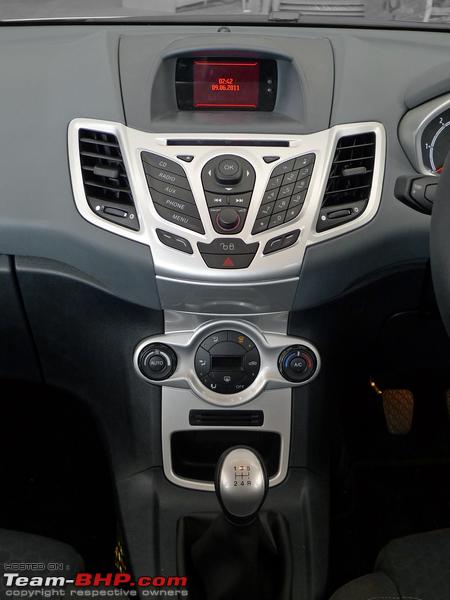 The 4-inch display above the audio system shows the time and date when the car is off 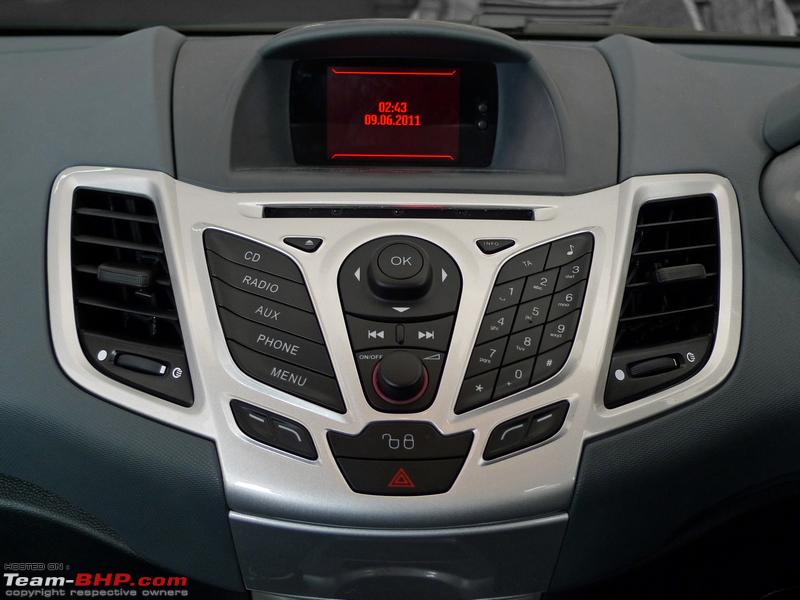 Well laid out AC controls  Sporty front seats with a deep bucket effect  Driver's seat height adjustment moves it up by 55 mm, screw type adjustment for the backrests  Smooth slotting 5-speed  The lit up foot well showing the standard rubberized pedals, an adequate dead pedal and a hood opener latch  Elegant & stylish integration of the push button (wiper spray) on the stalk  Dual stage convex mirrors provide an impressive field of view  Some of the many cubby holes provided. The 12v socket, USB and Aux-in are all conveniently located together  The bottle holder can hold a 1.5L bottle (picture shows 1L)  The glove box is about 12” wide, but it is very deep (downwards as well as into the dashboard)  Designers mimicked the styling language of modern electronic devices. Dash buttons are very short throw  The ONLY way to lock the doors  The temperature and fan-speed controls are a pleasure to use, but look a little plasticy  At the Rear Get settled on the rear bench and it doesn’t take long to notice that it’s a very stark contrast from the front half of the cabin. The unique styling, the modern touches and the metallic trim – are all gone. There isn’t even a ceiling mounted light, let alone individual ones above each door like on the Classic. The only two features back here (customizations for the Indian market) are the grab handles above the doors to aid ingress and egress, and the fold-down armrest with a cut out dual cup-holder. The next thing you’ll notice is the door panels. They look incredibly dull and the texturing leaves them with a very down-market feel. The rear door latch especially seems like it’s from a 3-Lakh Rupee hatchback, with multiple plastic parts all in the same monotonous black plastic. The latch feels flimsy too (in an otherwise solidly put together car). A touch of lighter / metallic trim panels and a chrome door handle could have drastically upgraded the feel back here. It’s also worth noting that there is no way for rear passengers to lock the doors themselves. As mentioned earlier, the cabin is wider than its predecessor, and there is more legroom available too. In terms of foot-room, it’s on par with the Vento and new Verna, with the City still maintaining its clear advantage here. The scooped out backs of the front seats also help with adding a valuable inch or two to the Fiesta’s foot room. The seating position is comfortable, and the compound of the rear bench cushioning gives good support too. In the Verna, the rear bench is positioned noticeably lower to accommodate the intruding roof-line, but the Fiesta’s rear bench doesn’t feel this way – despite a similar roofline. Headroom at the back maxes out for a 5’11” passenger sitting completely upright. The 5th (center) passenger isn’t as lucky, since the housing for the 3rd brake light intrudes into his headroom (picture below). There’s a 3-4” raised floor tunnel too, making the rear bench best suited for two. Even with the swooping roofline and window sills tapering up towards the tail, the rear half of the cabin does not feel claustrophobic at all. There’s significant glass area, large quarter glasses and the sharp rise of the sill-line only begins once it’s past your shoulder – letting in enough sunshine for an airy feel. The center armrest requires a really strong tug to pull open. Once it’s flipped open, the exposed hinges are an eyesore. You can sit with one arm on the door’s armrest, and the other arm on the center armrest, which is nicely cushioned. However, the center armrest seems to be placed about an inch too high (which is also an inch higher than the door armrest), making it a little awkward to use over longer periods of time. Comparing the amenities and feel for the front occupants vs the rear, it’s quite evident that Ford does not expect their target customer Ajay to be chauffer driven, but rather a self-driven man. All the features and fun are up front. The boot has a relatively high loading lip (711 mm), and the opening is quite narrow. Despite it measuring in at 430 liters (about 15% smaller in volume than the others in this segment), it should still be able to handle a fair load of baggage. This is the rear legroom behind a 5’8” driver. On par with the Vento and Verna  The fold out armrest is an inch too high, and the exposed hinges are an eyesore 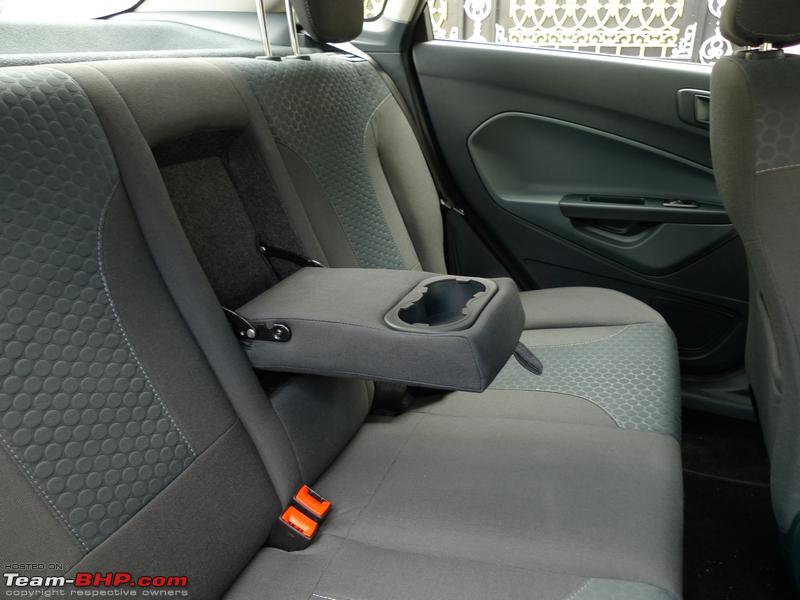 Monotonous rear door paneling 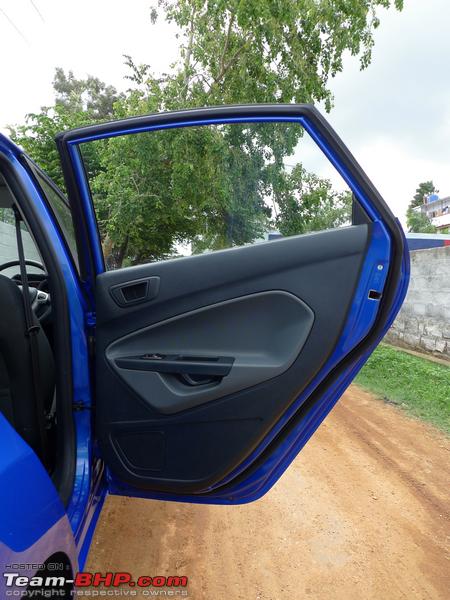 Cheap looking rear door handle  Adjustable rear head restraints are fairly hard, HMSL housing eats into the center passenger headroom 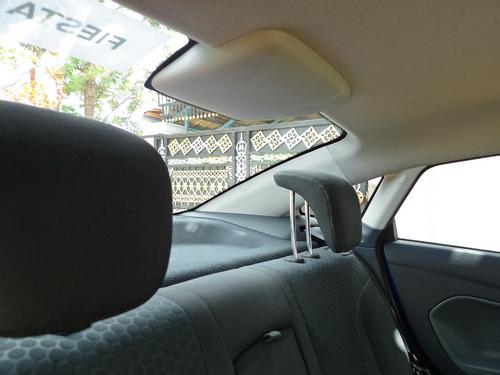 Two 6’2” guys sitting one behind the other seem to be doing okay 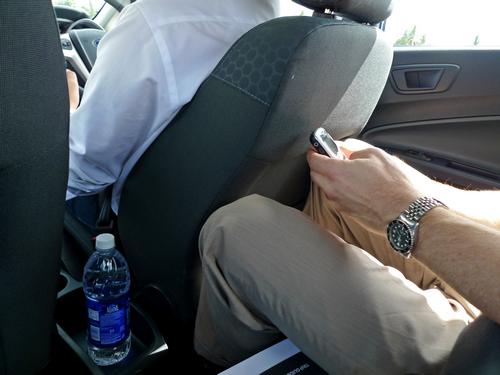 Plenty of space on the rear parcel shelf, it’s about 12” deep, and there’s a recess to keep stuff in place  430 liter boot is deep, though not very wide 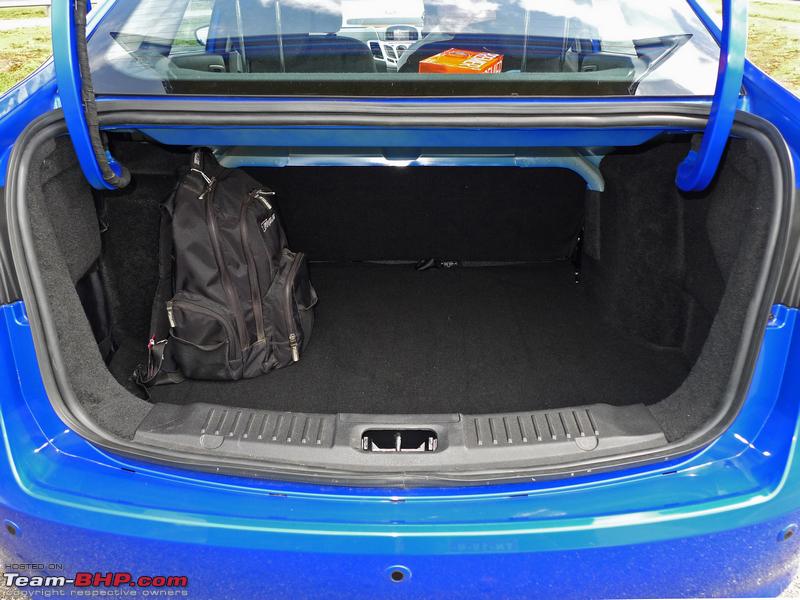 Last edited by Rehaan : 5th July 2011 at 11:52. |
| |  (14)
Thanks (14)
Thanks
 |
| The following 14 BHPians Thank Rehaan for this useful post: | avingodb, basilmabraham, dhanushs, echo77, Hatari, KL01BE, Klub Class, manishk83, niravdd, SankalpDesai, Surprise, TheBeastFieast, Xehaust, xPK |
| | #4 |
| Team-BHP Support  Join Date: Feb 2004 Location: Bombay
Posts: 24,037
Thanked: 34,067 Times
| Audio System & Voice Controls  Audio System The Fiesta’s audio system has 6 door-mounted speakers (2 being tweeters). Individual bass/mid/treble controls can adjust the sound in perfectly subtle steps. The pre-programmed EQ settings (Jazz, Rock etc) are also tastefully tweaked, and not massively different from each other just for the sake of being so. Adaptive volume (7-different levels + off) pumps up the volume as you go faster, to compensate for increased road and wind noise at speed. It works well, and you might even notice the sound level drop a little if you brake hard while at high speeds whilst enjoying some tunes. Aux-in has adjustable gain settings; useful if the volume output is particularly low or high on a device you intend to plug in. The full folder browsing and listing of your iPod / USB drive on the center display screen is excellent too. My only gripe is that if you select a song from the middle of the list, and then go back to the list, you start at the top all over again. I wish there was an easy way to “page-down” the list of tracks/folders instead of going one line at a time (perhaps those soft-keys could be put to work here!). Switching from radio back to USB starts playing your MP3 instantly, from the same point where you left off - neat. My iPod seemed to interface fine – but for some reason there was absolutely no sound output. It could be my non-iTunes managed iPod’s fault. So instead, I used my Android phone which the system instantly recognized as a USB drive, and it worked fine. The USB port even charged my phone at the same time (super useful since USB is the prevailing charging standard nowadays). I believe there is support for playlists too, though I did not get to test that out. Impressive audio quality, great soundstage with firm and powerful bass. Really well rounded for an OEM system. I’d give the audio system a solid 9/10 rating. The small icons on the left indicate the selected "Mode" : CD, Radio, USB, Phone and Settings  List style browsing of your iPod or USB device's files and folders  The functions listed at the bottom (repeat/shuffle/scan/info) show what the "soft keys" will do on this screen 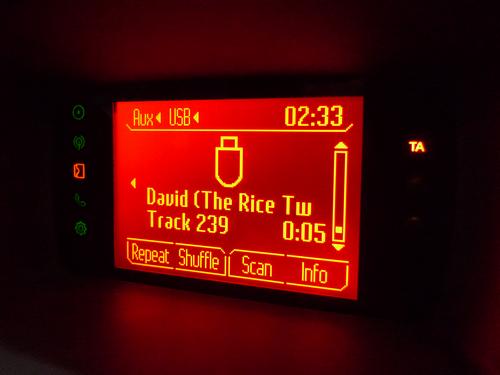 Voice controls Voice controls have been around on electronic devices for more than a decade now, and anyone who has ever played around with them knows that there’s a very fine line between being useful and being useless. So far, most attempts have been useless. It all comes down to accuracy. You ask for a copy and it gives you a coffee – no good. “Close enough” isn’t good enough. Ford has applied a basic work-around for this problem of accuracy, by limiting the voice controls to a specific set of pre-defined commands. This means the user will have to familiarize himself with these keywords, which is a bit of a learning curve. However, the end results are excellent! Kate with her limited vocabulary might not be the best conversation partner, but she’s very good at following instructions. After you press the voice command button on the left indicator stalk, she’ll ask you to speak, and then continue to wait patiently till you recite what it is that you want. Once you’ve spoken the command, she’s lightning quick to respond & confirm the command in her British accent too. There’s no noticeable lag, and it’s almost like a conversation with a real person. If you mess up while speaking a command (Did you know: the fear of public speaking ranks higher than arachnophobia), clicking the voice activation button once again will cancel the entire thing, and Kate wont get the opportunity to hear what you just said. Things you can say: "Climate"o Fan (followed by minimum, maximum or numerical speed from 1 to 7)"CD Player" Well, how useful is this in the real world? As cool as voice controls are, the reality is that a fan or temperature setting change would only take a quick swirl of the knob (which you could probably do without even taking your eyes off the road), and that would be about ten times faster that telling Kate to do it for you. But wait, that’s just a knob – a simple single functionality control. And it’s not very often that you hear someone say “sorry officer, I was trying to get the temperature just right and I didn’t notice that red light”. Cell phones. That’s where the voice activation will not only be incredibly useful, but a life-saver too. Link your phone up to the Fiesta via Bluetooth, and instead of you performing several key-presses, visual double checks on the small screen and juggling the device between gear changes and steering inputs – Kate will do it all for you. You can pre-record your pronunciation for the entries in your phone-book too, leading to increased accuracy whilst overcoming any pronunciation barriers Kate might face. Want to give your buddy Krishnakumar Balasubramanian a call? No problem! I must say, Ford has done a great job with the electronics integration of this car. There’s even a neat little “wipe-out” animation when resetting the trip-meter. Press this button to trigger a voice command  The display shows when its ready, and sounds a beep. The progress-bar goes slowly from left to right in anticipation  The mic is housed up here  A 16-second video demo Last edited by Rehaan : 21st June 2011 at 12:43. |
| |  (21)
Thanks (21)
Thanks
 |
| The following 21 BHPians Thank Rehaan for this useful post: | aby, Aragorn, architect, basilmabraham, dhanushs, diffsoft, echo77, Klub Class, manishk83, niravdd, ritzy, SaiSW, SankalpDesai, SJD@NewDelhi, supremoo, Surprise, swiftnfurious, TheBeastFieast, Xehaust, xPK, _raVan_ |
| | #5 |
| Team-BHP Support  Join Date: Feb 2004 Location: Bombay
Posts: 24,037
Thanked: 34,067 Times
| Engines & Driving Impression In a move that surprised a lot of the eagerly waiting audience, Ford announced that both engines for the new Fiesta would be 1.5 Liter units, rather than retaining or stepping up the displacement of its existing 1.4L Duratorq (diesel) and 1.6L Duratec (petrol). This left a lot of us wondering, will a 1.5L petrol with variable valve timing be able to match the older, much loved 1.6 mill from the Classic? Will the petrol Fiesta still be as much fun? And, why on earth did Ford do this? Well, there are a couple of reasons why 1.5L displacement was chosen. Firstly, though these engines are going to be manufactured in Ford’s Chennai plant (link), they will be the global engines sold in Fiestas across the world (this was the worldwide debut of these power-trains!). A lot of countries have their regulations structured in a way that favours 1.5 liters as the highest common factor. China, for example, breaks up incentives for engine classes in 1.5L increments, and India has an excise benefit for Diesel engines which are less than 1500cc. Fuel efficiency was obviously another major factor, and from what the ARAI reports of their synthetic tests, these engines do deliver impressive figures of 17 kpl on the petrol, and 23.5 kpl on the diesel. Both engines use an aluminum alloy block and head. Naturally, being produced in India, the power-train has a high level of localization, though Ford hasn’t specified the percentages.  Petrol Engine The Duratec Ti-VCT (Twin Independent Variable Camshaft Timing) has an output of 108 BHP @ 6045 RPM and 140 Nm of torque @ 4500 RPM. It redlines at 6,000 RPM and has an 11.1 compression ratio. Crank the key and you can barely hear the petrol start up. The NVH (noise, vibration, harshness) of the cabin is well controlled. Even though the petrol is not full of torque below 2,000 RPM, it never feels like its struggling with the load. The petrol only really starts to respond past 2,200 RPM. Slamming your foot to the floor before that will do absolutely nothing. Expect to work the gearbox a lot to get the maximum out of the engine, especially when overtaking. The new 1.5 petrol just doesn’t have the low-down torque to match the old 1.6 engine. Below 3,000 RPM, there’s no contest. Add to that, the gearing of the new Fiesta is noticeably taller than the Classic (though no figures have been released yet) – this would be a major contributing factor to the difference in peppiness and feel between the two cars, and also greatly responsible for the high ARAI fuel efficiency figures! The engine note becomes more noticeable at 4,000 RPM plus, enough to keep you involved when high-revving and let you know what’s happening – just like the old Fiesta (though on a slightly different note). From a purely enthusiast point of view however, the word for the petrol engine, especially in comparison with the previous 1.6 Duratec is – disappointing. I should mention that the 3,020 ft elevation of Bangalore left us with a significant 9.8 BHP loss for this naturally aspirated Petrol (due to the rarified air at this altitude). This is definitely in part responsible for dulling down the engine a little. Nonetheless, even if we were at sea level, it would still seem like a notch towards the mass market, and a step away from the hardcore Fiesta fans. However, the rest of the package and driving dynamics of this car are still very capable of delivering a fun and involving drive, especially around the corners. More on that below. For the average consumer, the petrol engine certainly isn’t bad, but then, I’m not sure why they would choose it over the diesel… Diesel Engine The 1498 cc Duratorq TDCi puts out 90 BHP @ 3,750 RPM and 204 Nm of torque @ 2000 - 2750 RPM. It’s a SOHC engine with a fixed geometry turbo and an intercooler. You can only hear the muted hum of the diesel, there’s no clatter either at idle or when revving. Moving from a standstill, the additional torque is instantly noticeable over the petrol. Despite being a diesel, the engine isn’t very lug-friendly (due to tall gearing?). If you get too low in the RPM range (in 2nd or 3rd gear), the car will start to jerk violently. As you go through the revs, you’ll notice that there’s no solid power-whack, but there’s no major turbo-lag either. There’s a linear push of power all through, with mild peaks at 1800 RPM and 2200 RPM. The diesel is marked at a 4,500 RPM redline. Up till about 4,000 RPM the 1.5L mill revs happily, not showing any strain or coarseness. However progress is very slow after 4,000 RPM, prompting you to up-shift earlier. If you’re on the highway and pick a higher gear, cruising in triple digit speeds is quite effortless. At the tail end of our drive, a voice came in over the walkie-talkies. A question for everyone test driving the cars : “So guys, what will it be? Petrol or Diesel?”. In came the stream of replies “Diesel”. “Diesel”. “Definitely the diesel”. I agreed. It also worth mentioning that being a forced induction engine (unlike the petrol), the diesel would be less susceptible to shortage of breath due to Bangalore’s altitude. Though just to be clear, even though the diesel is the engine of choice between the two, its still not going to get your pulse racing. Steering “EPAS” = Electric Power Assisted Steering, means that instead of the conventional hydraulic pump that is continuously running off the engine and making the steering lighter for you, this electronic unit activates an electric motor to assist you with the steering only when required. This Fiesta is the first ever Ford car to have an EPS unit (column mounted motor in this case), but expect to see the EPS make its way to almost all Ford’s offerings over the next 3 years. For an EPS unit, the steering feel is impressive. There isn’t much feedback from the road (just like most other consumer cars), yet the feel, the turn-in, the directness and the weight are all excellent and do a good job of complimenting the road behaviour of the Fiesta. Ford engineers have obviously spent a lot of time calibrating this system to be as involving as possible. An average driver would have a hard time telling that this was in fact an EPS, but they would yet enjoy the benefits of more assist at slower speeds, and a small fuel efficiency gain over the hydraulic unit. Unlike most EPS cars where you can tell exactly when the control switches from one setting to the next, on the Fiesta it’s a very smooth transition with around 5 transition stages – which means you’re much less likely to feel a sudden or drastic change in steering weight as you slow down or speed up. Interestingly, even at parking speeds where the EPS is at its lightest settings, it’s still not quite as super-light as the EPS in the Vento or Polo. “Pull drift compensation”. Don’t expect too much from this. It’s rare that it will come into effect, and it’s even less likely that you’ll notice. In one sentence: if the system notices that you are constantly holding the steering slightly off center (eg. to combat a cross-wind), it will apply some additional assistance to make it less of an effort for you. That’s it. The steering has a 15.1 turning ratio, this is more towards the sensitive side (typically cars are between a very quick 12:1 and more gradual 20:1). What this means is that you’re likely to experience more turning of the car with less turning of the steering wheel. Part of Ford’s driving DNA as they say. Another figure that’s probably more relevant to us city slickers is the 5.2 meter turning radius. Driving Impression From slow speed driving within the city, it seems like the suspension set-up is actually a little firmer than the Fiesta Classic, (eg. Noticeable when going over speed breakers). “ Taut” would be the best word to describe it. At mid-40 speeds on a bumpy/country tarmac road, you feel every single bump, mound and undulation quite noticeably through the suspension, though not in a bone-jarring way. There’s no aspect of this suspension set-up that feels cushioned, soft or floaty. As a result of this suspension setup, body roll is well controlled, and the car has a planted feel at high speeds and holds its line beautifully around corners. It’s very mature and composed. Unfortunately, the handling couldn’t really be tested anywhere close to its limits since the route we had to stick to on this drive was mostly fast flowing blacktop, with no ascents or twisties. The one circling highway on-ramp that I flung her into had the passenger in my car making more noise than the tyres. That’s a fairly positive indicator for road holding. The brake pedal feel has been tweaked for India. It was made a little less grabby and more linear (smoother in our start-stop traffic conditions). The overall braking performance remains unchanged. Brake pedal feel is relatively firm and the resultant action is very confidence inspiring and linear. At higher speeds (~140 km/h), some very minor corrections were required during emergency braking, even though the ABS did not activate. The clutch is definitely not feather-light, and in crawling bumper to bumper traffic, could get tiring to operate. There’s no perceivable difference in weight between the diesel and petrol clutches. Same goes for the 5-speed gearbox – the feel is identical across engines. The gates are well defined, throw is medium length, shifter height is just right and it slots in nice & easy every single time. Wind and road noise are well controlled. Even at a 100+, there’s no need to raise your voice at all. The AC however does get a bit noisy at the vents when it’s at blower speed 4 or higher (of 7). Ground clearance is 168 mm. We didn’t have any issues with average sized speed breakers and 3 occupants in the car. High-frequency shielding for the NVH of the diesel engine is the only reason for the plastic cover which has a layer of insulation under it  Engine badging only on the diesel  More noise insulation up here  The narrow brick style intercooler is visible on the left. On the right is the AC condenser and radiator (further behind)  The fuel flap is clearly marked on the Diesel, though the petrol one has no markings  Look halfway down the rod that keeps the hood open. There is a little rubber piece that keeps the rod flexed into position tightly, preventing it from rattling around  Last edited by Rehaan : 15th July 2011 at 17:23. Reason: Adding GC |
| |  (18)
Thanks (18)
Thanks
 |
| The following 18 BHPians Thank Rehaan for this useful post: | aby, Aragorn, architect, basilmabraham, dhanushs, echo77, Klub Class, lijodavis, manishk83, Mustang.101, naveen.raju, niravdd, nk1969, Surprise, swiftnfurious, TheBeastFieast, Xehaust, xPK |
| | #6 |
| Team-BHP Support  Join Date: Feb 2004 Location: Bombay
Posts: 24,037
Thanked: 34,067 Times
| Other Points Other Points • In what is an extremely welcome move, ABS & Dual-Airbags will be standard across the range (including on the starting variant). • This is the first of eight new vehicles that Ford plans to launch in India over the next 4 years! (link) • The dash design makes after-market head units seem impossible. But it isn’t the case. Dash kits are available on int’l eBay for single DIN and double DIN units. • Ford offers a 2 year / 100,000 km warranty as standard. • Ford’s “child parts” system (link) will be applicable to the new Fiesta too. It enables the replacements of smaller sub-parts, rather than entire components, with the aim of reducing cost to the end user. • Unlike the previous-gen we’ve had in India, this Mk VI Fiesta is also sold in Ford’s largest market, and home, the USA. • Despite an evident demand for Beige interiors, the Fiesta doesn’t have them as an option. The stated reason for this is that they do not suit Indian conditions as they are hard to maintain. The ironic part is they are available on the dirt-eating Endeavour. • The AT version actually got better FE figures than the MT in the USA tests. There are three reasons for this: it’s a dual-clutch, so there’s no wasteful torque converter in there; the optimal shift points are pre-programmed in; and the AT is a 6-speed whereas the manual is a 5-speed. Ford, here’s your chance to bring in this DCT and capture this niche. More-so if it’s paired to a diesel engine! • Unlike the counterparts overseas, the Indian Fiesta has no engine start/stop button. • The Fiesta is available in eight colours: Diamond White, Moondust Silver, Sea Grey, Chill, Morello, Panther Black, Squeeze and Kinetic Blue. • Rear windows go about 85-90% of the way down, but not all the way. • Thanks to Stratos for post processing the images and GTO for helping with the write-up. • Disclaimer : Ford invited Team-BHP for the Fiesta test-drive. They covered all the expenses for this driving event. Last edited by Rehaan : 19th July 2011 at 16:52. |
| |  (31)
Thanks (31)
Thanks
 |
| The following 31 BHPians Thank Rehaan for this useful post: | aby, amitkb, anilisanil, Aragorn, architect, aryasanyal, basilmabraham, Desmosedici, dhanushs, dot, echo77, frankmehta, gishu, Klub Class, lijodavis, mayankjha1806, Motored Mindset, musicvj, nileshch, niravdd, ontheroad, ritzy, S5157, SankalpDesai, somjith_nair, Surprise, swiftnfurious, TheBeastFieast, vina, vinu99@gmail.co, xPK |
| | #7 |
| Team-BHP Support  Join Date: Feb 2004 Location: Bombay
Posts: 24,037
Thanked: 34,067 Times
| Re: Ford Fiesta : Test Drive & Review The Smaller Yet Significant Things Net pocket in the passenger's foot well  Soft touch button to open the boot  Foldable key, available across all variants, can open the boot too  Locking latch system on the floor-mat prevents it from sliding out of place 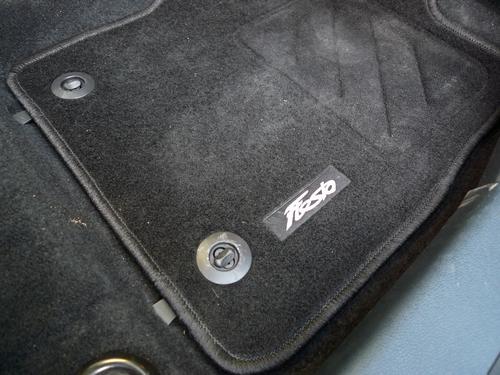 Yet another cubby hole! There’s really a lot of them  What is this mysterious little flap? It was an add-on so the car could meet homologation requirements in certain countries that require a certain percentage of the wheel to be covered by the wheel arch.  Center-mounted antenna 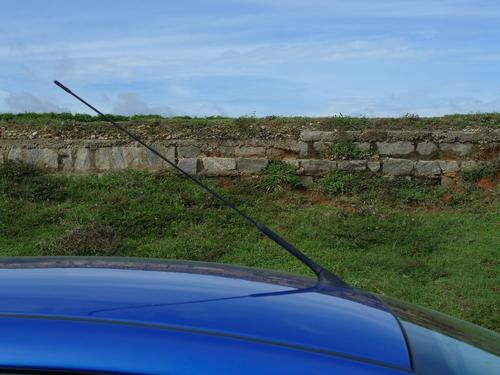 A ceiling mounted net pouch  Spare wheel is a 14" steel wheel, not a 15" alloy  Interesting dual textured fabric on the seats  Seat-back pockets have a felt lining inside  Conveniently styled grab and pull handle for adjusting the front seat fore/aft positioning  Adjust the electric mirrors, or push the knob downwards to fold/unfold them  Mirrors on both sun-visors. Equality of the sexes?  Surprise! A storage drawer under the passenger's seat  Smartly designed door pockets can hold a 1.5L bottle in that little chicane  A closer look at the carved out seat-backs - for maximizing knee-room  Height adjustable seatbelts up front  How cool is this? Too bad my iPod didn’t work though!  Rear seat folds forward to help carry larger stuff. There is no 60:40 split, its a one piece seat-back  Dual front airbags, and the familiar Ford AC vent (though the center ones are a different design!)  Light switches are rubberized, and the headlight height adjustment has a nice clicking feel to its adjustment. Don’t miss the individual front and rear fog-light buttons 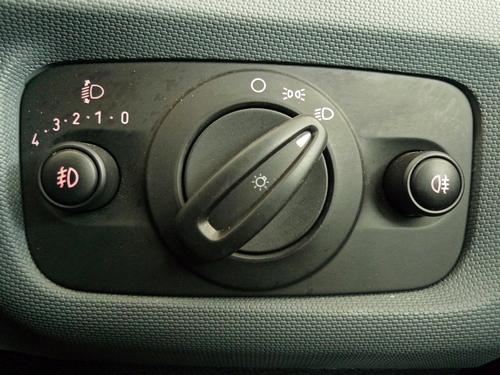 The cluster looks nice all lit up (Not all indicators shown may actually have the related function on the Indian Fiesta - its just a universally used cluster) 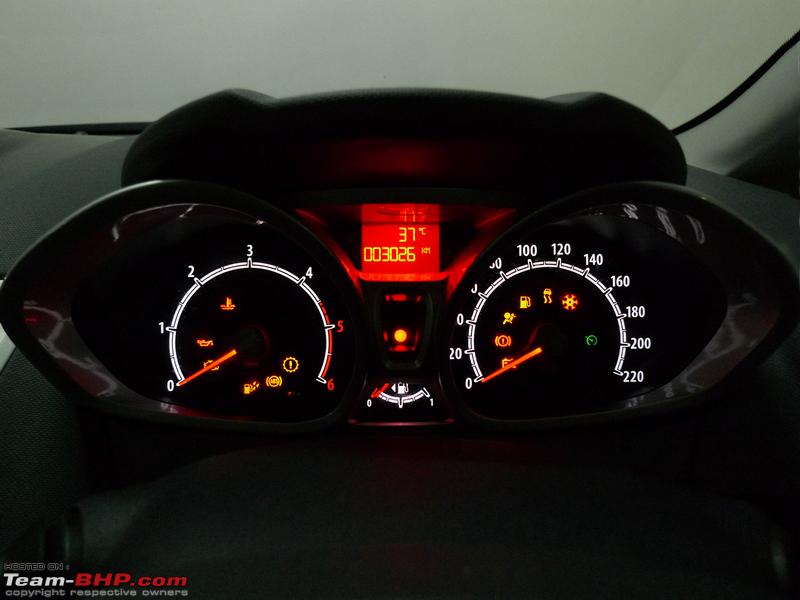 Warnings are overlaid on the main display. There’s progress-bar at the bottom that indicates how long before the warning disappears  Last edited by Rehaan : 21st June 2011 at 16:03. |
| |  (26)
Thanks (26)
Thanks
 |
| The following 26 BHPians Thank Rehaan for this useful post: | adentist, adityamunshi, basilmabraham, dhanushs, diffsoft, drchernish, echo77, himavanth_m, Klub Class, lijodavis, manishk83, mohandas, nairrk, nileshch, niravdd, pankaj_sachdeva, rajswiftvdi, SaiSW, SankalpDesai, speed kills, sreepy, Surprise, swiftnfurious, TheBeastFieast, Xehaust, xPK |
| | #8 |
| Team-BHP Support  Join Date: Feb 2004 Location: Bombay
Posts: 24,037
Thanked: 34,067 Times
| Re: Ford Fiesta : Test Drive & Review Chief Competitors of the Ford Fiesta Honda City: 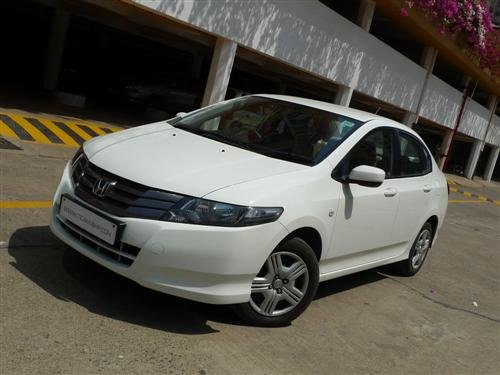 Owners liked: - Modern styling and design - Outright engine performance - Spacious well-designed interiors - Honda reliability & durability Owners disliked: - Cheap interior part quality - Sparse equipment list - Lacks the quality of outgoing generation - Below average customer support VW Vento: 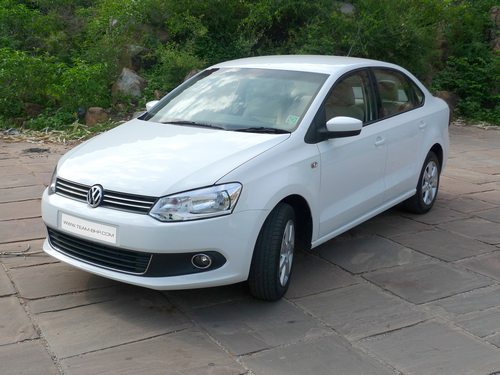 Owners liked: - Well-built, robust, European sedan - Clean and contemporary styling. - Competitive pricing, especially for a German car - Stunning diesel engine. - Mature suspension setup. Balanced ride & handling - Segment firsts : Reach adjust steering, gear recommender, adjustable driver armrest etc. - All-rounded nature; Jack of all trades Owners disliked: - 6.99L Trendline (entry) variant is simply too basic. No Comfortline (middle) variant - Petrol engine isn't as impressive as the diesel. Average low rpm response - Electric power steering. The Vento deserves a pure hydraulic unit - Some goodies missing (steering-mounted audio controls, AUX / USB stereo, dead pedal & folding rear seat) - Thin 47 dealer all-India network. - VW's long-term ownership costs are unknown Hyundai Verna:  Owners liked: - A great looking Hyundai sedan - Well-packaged; sufficient room front & back - Competent 1.6L powerplants, especially torquey diesel. Wide range of engines & transmissions on offer - Ride quality & behaviour in the city - Several segment-first features (reversing camera, keyless entry & go, electric folding mirrors and more) - Top notch safety equipment including 6 airbags, ABS + EBD, all wheel disc brakes etc. Owners disliked: - Dynamics & high speed handling capability. Softly tuned suspension - High speed ride quality isn't flat. Suspension, especially on uneven roads, gets wallowy - 4 speed Automatic gearboxes. This segment calls for a 5 speed - Under-thigh support of the low rear seat not as good as that of competition Maruti SX4: 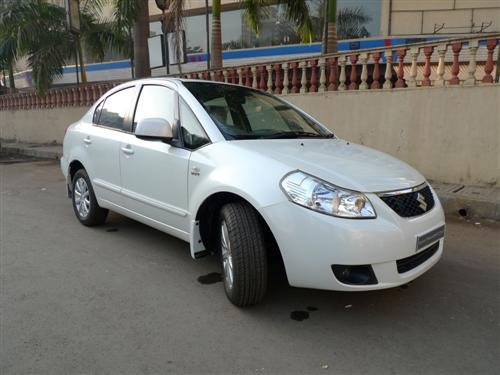 Owners liked: - Value-driven pricing - Solid build quality - Quick petrol engine - Safety features on offer - Spacious and well-spec'ed interiors - Fantastic Maruti service Owners disliked: - Stiff ride quality at low speeds - Lack of overall quality - Sub-par fit and finish for the price - Low engine refinement levels - Rear seat center-hump Fiat Linea: 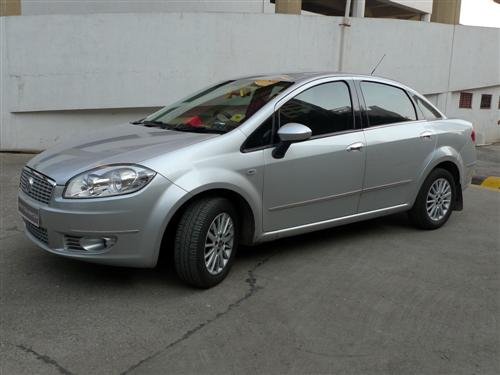 Owners liked: - Elegant styling - Solid build quality - Fuel-efficient diesel - Brilliant handling & dynamics - Mature ride quality - Top level of equipment Owners disliked: - Compact rear seat confines - Lack of outright performance from 1.4 N/A & 1.3 MJD - Interior fit, finish and quality are below average - Shoddy after-sales support - Niggling issues NOTE : Competitor information sourced from the Team-BHP Ownership Review Section (except Vento & Verna, which are from Forum reviews). Last edited by GTO : 21st June 2011 at 12:05. Reason: Adding competitor info |
| |  (27)
Thanks (27)
Thanks
 |
| The following 27 BHPians Thank Rehaan for this useful post: | --gKrish--, aby, AjiGTI, basilmabraham, camon, echo77, fluidic_fan, fullspeedahead, iliketurtles, inomad, Klub Class, LobsterB, moralfibre, musicvj, naveen.raju, niravdd, pjbiju, PPS, Rach, SankalpDesai, SilkDrive, Sugeeta, TheBeastFieast, Xehaust, xPK, yajaman99, _raVan_ |
| | #9 |
| Team-BHP Support  | Re: Ford Fiesta : Test Drive & Review Absolutely loved the witty comments, Rehaan! Thanks for sharing this definitive Ford Fiesta review with the rest of us. Pictures are outstanding as well. *Rates thread a well-deserved 5 stars*. Ford has clearly adopted a neutral stance with the new Fiesta. Does most things right & few things wrong. It reminds me of the Figo's neutral nature in many ways. The petrol seems terribly lackluster, but it won't make a difference to the market, what with petrol prices the way that they are. A majority of her sales will be in diesel. The torquey, fuel-efficient nature will keep the mass market happy. Driving enthusiasts though will be headed the sweet Linea T-Jet / torque-monster Vento diesel way. @ Ford : Don't miss the AT diesel segment that's just waiting to be tapped. It'll find many takers in urban India. Too bad about the exit of the "famed" 1.6L 100 BHP motor. It was a jewel of an engine that was equally at home in bumper to bumper traffic, as it was high-revving on the open road. I'm surprised & disappointed at the stark contrast between the old 1.6L and the new 1.5L petrol. Equally, I welcome the new 1.5L diesel. The 1.4L 68 BHP motor was simply too puny for the C segment. I love the futuristic face of the Fiesta as much as I hate the rear end. I also find the dash real funky, and the voice commands / cruise control etc. should give it some differentiation in the eyes of the increasingly discerning C-segment customer. The market continues to heat up  Last edited by GTO : 21st June 2011 at 11:44. |
| |  (1)
Thanks (1)
Thanks
 |
| The following BHPian Thanks GTO for this useful post: | swiftnfurious |
| | #10 |
| Senior - BHPian Join Date: Oct 2008 Location: kolkata/bangalore,india
Posts: 2,901
Thanked: 4,142 Times
| Re: Ford Fiesta : Test Drive & Review Have not yet read a word of the review,but just so glad to see it.Thank you all!Have been waiting for days on end for the review. And that blue looks brilliant! |
| |  ()
Thanks ()
Thanks
 |
| | #11 |
| BHPian Join Date: Jul 2007 Location: Hyderabad
Posts: 35
Thanked: 9 Times
| Re: Ford Fiesta : Test Drive & Review Great review Rehaan. Hopefully Ford will price the car right. Would love to see aggressive pricing like the Figo's. |
| |  (3)
Thanks (3)
Thanks
 |
| The following 3 BHPians Thank adentist for this useful post: | camon, muni, tazmaan |
| |
| | #12 |
| BHPian | Re: Ford Fiesta : Test Drive & Review Great review. The Verna and the New ford fiesta seem very similar to me. Both are very fluidic. Also from the pictures it can be seen that all the concentration was on front dashboard by the Ford Engineers and completely forgot about rear interiors. The rears in the interior look cheap very much unlike the front dashboard which looks splendid. Can someone rate Vento, Verna and Fiesta in terms if interior plastic quality and fit and finish? I doubt how a 1.5 L bottle can fit in such a small hole. I would love to see a pic of a bottle in this. |
| |  ()
Thanks ()
Thanks
 |
| | #13 |
| BHPian Join Date: Jan 2011 Location: Pune
Posts: 360
Thanked: 121 Times
| Re: Ford Fiesta : Test Drive & Review Thanks Team-BHP So finally we have NFS review, couldn't believe to be an early bird to check this out! Still 9 days to go for Q3, don't know when in Q3 Ford is going to announce pricing? Thats a heck Great review Rehaan. |
| |  ()
Thanks ()
Thanks
 |
| | #14 |
| Senior - BHPian Join Date: Oct 2006 Location: Bangalore
Posts: 1,196
Thanked: 166 Times
| Re: Ford Fiesta : Test Drive & Review Super review, thank you. The petrol is a disappointment after the 1.6 Ikon & Fiesta Mark I. That racy blue colour looks awesome on most fast fords and the Fiesta is no exception..though the rear looks are a definite deal breaker. Will wait for the Fiesta hatch in kinetic blue. |
| |  ()
Thanks ()
Thanks
 |
| | #15 |
| BHPian Join Date: Dec 2008 Location: Mumbai
Posts: 157
Thanked: 61 Times
| Re: Ford Fiesta : Test Drive & Review Great review Rehaan, 5*. As mentioned by GTO too, the diesel auto segment is something that most auto makers are ignoring very conveniently. To think of it some of us city slickers who in mumbai are used to really bad bumper to bumper traffic would love an affordable diesel auto. There is no diesel auto this side of 10L and the only other diesel auto is the New Verna (with the poor 4 Speed One). I would love to upgrade to good diesel auto but the only one left is the Cruze AT which at the moment is out of my reach  The New Fiesta is great in the middle car. I sincerely hope they launch an auto and if they do I am definitely in line for one. |
| |  (2)
Thanks (2)
Thanks
 |
| The following 2 BHPians Thank siddharthdeb for this useful post: | camon, kar.carthik |
 |


